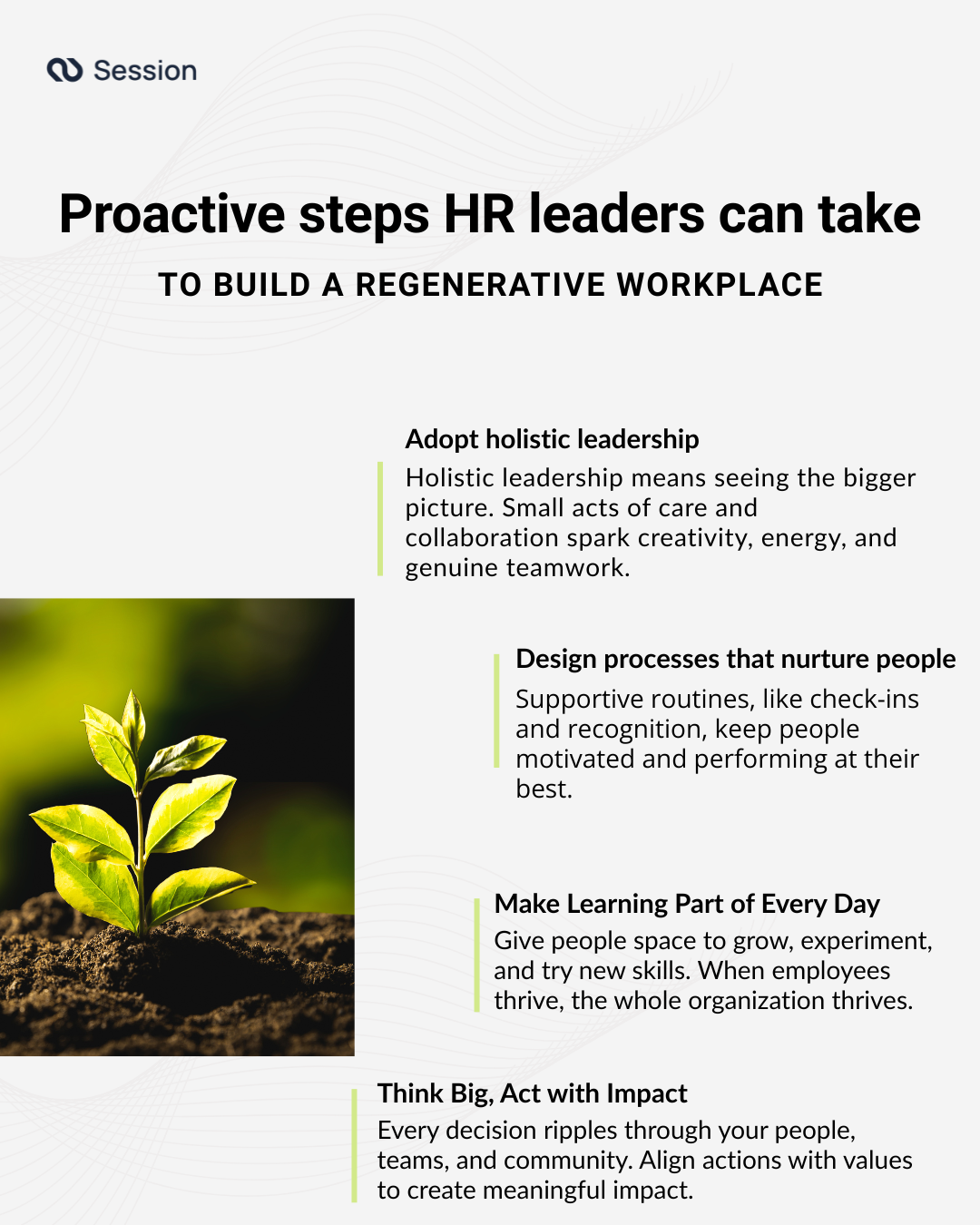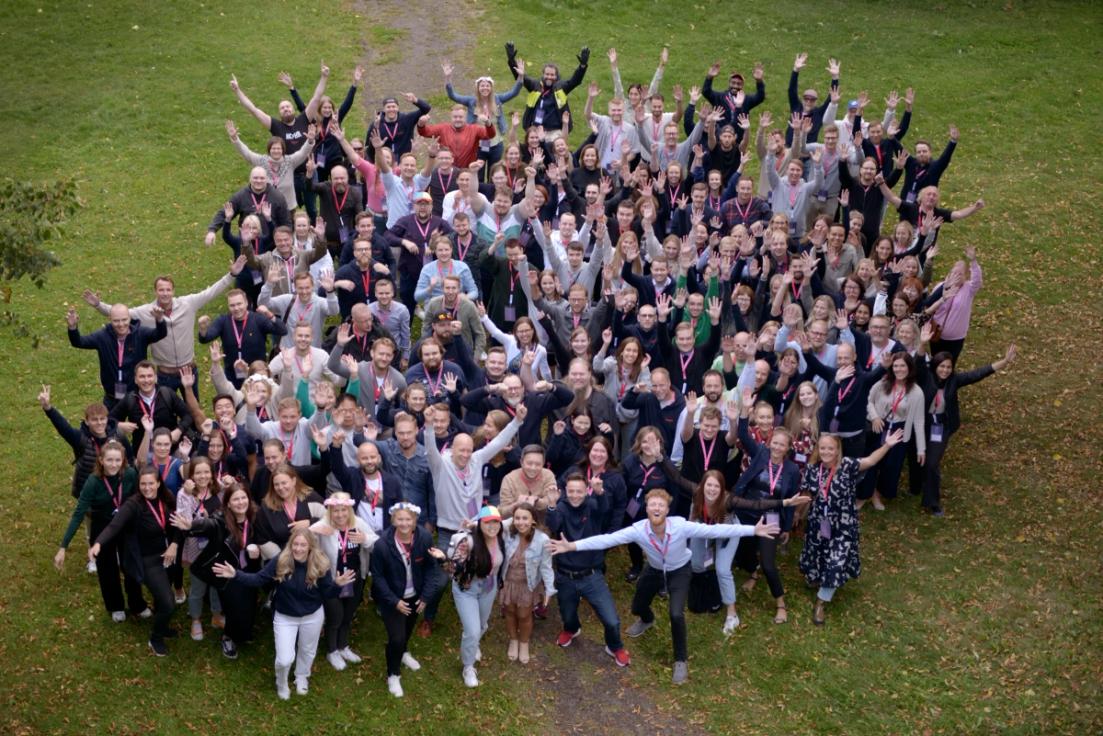Younger generations are reshaping the way we think about work, and they’re not shy about asking for something different. They want more flexibility in how and where they work, with remote options being high on the list. They’re also questioning traditional structures, leaning towards self-management and, in some cases, even workplaces without formal managers.
But it’s not just about flexibility, nor just about generations. People want their work to matter, no matter their age. They’re looking for roles that connect to a bigger purpose and make a positive impact in the world. At the same time, they crave smart, digital tools that save time and remove friction, rather than waste it on endless folders and confusing systems.
And, they want to feel good at work. They want laughter, genuine connection, and an environment where they can be themselves. Work isn't just about completing tasks, it’s about being part of something meaningful and human.
Regeneration
Instead of focusing on fast solutions or individual parts, regeneration invites us to step back and look at the system as a whole. It’s an approach to leadership and organizational development that’s about giving more than we take. It’s about creating new energy and possibilities, not just restoring what’s broken or optimizing what already exists. It’s about sparking innovation and fresh thinking rather than simply maintenance. Most importantly, it’s about shaping the conditions where both people and organizations can continuously grow, adapt, and renew themselves.
The idea of regeneration actually stems from the climate crisis; the realization that we’re slowly eroding the very foundations that make life possible: biodiversity, clean air, safe drinking water, and access to resources for the future. Right now, we’re consuming more than we return, polluting more than we clean, and taking more than we give back. In financial terms, it’s like living off credit, and the bill is coming due.
Regeneration does not necessarily mean transforming your entire organization and starting from a clean slate. Many HR functions may already be working smoothly, however, with regeneration comes the opportunity to take these functions and adapt them, further enhancing the models and practices in place.
Humane, diverse, and equitable organizations
When the world feels stretched to its breaking point, organizations face a choice: keep draining people, or become places that give energy back. This is the real opportunity; to create organizations that act like living ecosystems, thriving on diversity, compassion, and connection. But knowing it’s the right direction is only the first step. The real impact comes from action. HR leaders, in particular, have a unique opportunity to turn this vision into reality. The next step is about putting practical, proactive measures in place that make regeneration, growth, and well-being part of the everyday experience.
Proactive steps HR leaders can take to move the needle

- Adopt holistic leadership, support, and collaboration practices.
Holistic leadership is about seeing the bigger picture; understanding how every choice ripples through the organization, encouraging people to work together, and creating support systems where everyone feels valued and able to do their best. When teams take care of their overall well-being: physical, mental, emotional, and even spiritual, they don’t just perform better; they have more energy, solve problems more creatively, and genuinely enjoy working together.
Support doesn’t have to be complicated. Sometimes it’s as simple as noticing when someone’s struggling and starting a conversation, or focusing on what people do best instead of constantly pointing out their weaknesses. Small gestures like these can make a huge difference in helping people feel seen, valued, and capable of doing their best work.
2. Design processes that nurture people and performance.
When employees are truly engaged, they bring more energy, enthusiasm, and commitment to their work. Strong performance management helps keep this motivation high and drives better results across the board. Processes to implement could look like regular check-ins and supportive conversations. These are simple but intentional touchpoints where managers or peers notice when someone is struggling and offer guidance, feedback, or just a listening ear. Strengths-based development additionally offers a highly beneficial way of nurturing employees, as instead of focusing on weaknesses, processes can highlight and build on individual strengths, giving employees opportunities to excel in what they do best. Simple rituals or tools to recognize contributions, achievements, and collaborative efforts can also be implemented to remind employees that their work is noticed and appreciated.
3. Embed continuous learning and renewal.
Creating a regenerative workplace means thinking beyond only support mechanisms. It’s equally about growth. Embedding continuous learning is about giving people the space and encouragement to try new things, explore new skills, and stretch themselves without fear. This could be anything from mentoring, workshops, and courses to simply allowing room to experiment and learn from mistakes in every-day tasks. When learning and renewal are part of the everyday flow, employees stay inspired, and ready to bring fresh ideas to the table. And when people grow, the whole organization grows with them.
4. Stay aware of trends and think systemically.
Before rolling out any new initiative, whether it’s a policy change, a leadership program, or a new workplace perk, it’s important to pause and look at the bigger picture. How will it affect employees, teams, the organization as a whole, and even the community or environment? Small changes can create ripple effects, both positive and negative. By aligning every decision with your values and your goal of building a humane, diverse, and equitable workplace, you can focus on initiatives that truly make a difference, while rethinking or pausing those that could have unintended consequences.
This aligns closely with consumer expectations: Winn’s 2025 CSR report shows that 77% of consumers prefer to support companies with a positive social impact, highlighting just how closely modern consumer behavior is tied to sustainability and ethical practices.
Conclusion
The shift to regenerative approaches and more organizations focusing on sustainable outcomes shows us that work simply isn’t just about tasks anymore, it’s about the people. The organizations that thrive are the ones that lift people up, give them space to grow, and make work feel meaningful. By leading holistically, supporting your team, building processes that actually help, and encouraging continuous learning, you create a workplace where people feel seen, valued, and ready to do their best.
When we design work around humanity, fairness, and connection, everyone wins; employees, the organization, and in doing so, leave a mark that extends beyond the workplace.













